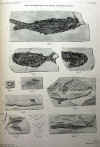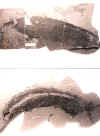ANASPIDS
The name anaspid bears reference to the fact these fish lack a head shield. The fish are fusiform and somewhat laterally compressed, being usually characterised by the presence of postbranchial tri-radiate spines and a hypocercal tail.. Some, such as Birkenia are covered in dorsoventrally elongated scales, others such as Lasanius are naked except for the dorsal row of ridge scales. Most are of late Silurian age, but Jamoytius (the oldest anaspid) shares several features with Endeiolepis from the Upper Devonian of Miguasha and while both forms do possess the strongly hypocercal tail, they do not display postbranchial spines. Anaspids seem to be closely related to the Lampreys (hypocercal tail, dorsal nasohypophysial opening and gill openings slanting posteriorly), with Jamoytius exhibiting features from both. This relationship is the subject of great debate and many of the characteristics above are shared with the Osteostracans.
I am fortunate to have a copy of the magnificent "REPORT ON FOSSIL FISHES" COLLECTED BY THE GEOLOGICAL SURVEY OF SCOTLAND IN THE SILURIAN ROCKS OF THE SOUTH OF SCOTLAND -1899 BY RAMSAY H. TRAQUAIR. In it he writes the following;
Order ANASPIDA - The two remarkable genera to be now described (Lasanius and Birkenia) are so unlike any other fishes hitherto known that I feel under the necessity of erecting a new order for their reception. One interesting feature of this work is all the diagrams and plates (see bottom of page) show the fish upside down, with what we now know to be the ridge scales underneath

In the UK, Anaspids have been found in several sites around the village of Lesmahagow in Scotland, including the legendary Birk Knowes -all are now protected
Anaspids in my collection (click on thumbnails to see larger images)
Birkenia elegans, Silurian, Lesmahagow, Scotland
Birkenia was a derived form of anaspid that grew to a maximum length of about 10 cm . It was was adapted for active swimming, and had a sucking mouth that was terminal rather than ventral. Unlike the ostracoderms with their fused bony headshield, the skull of Birkenia was covered by small scales. As can be seen below, it has the characteristic anaspid hypocercal tail with the main axis of the tail fin (the lobe containing the notochord) going to the posteroventral lobe. It is also lacking pectoral and pelvic fins, has an enlarged row of median dorsal ridge scales/spines and a much reduced anal fin.
 Tail of Birkenia showing the strongly hypocercal features
Tail of Birkenia showing the strongly hypocercal features
Jamoytius kerwoodi, Silurian(Llandovery), Lesmahagow, Scotland
A fossil fish with paired fins named Jamoytius kerwoodi was found in the Llandovery rocks of Lesmahagow. The anatomy and affinities of Jamoytius have long been controversial and its preservation as a flattened organic film makes the interpretation of features difficult. Jamoytius. Its preserved features include W-shaped carbonized scales, more than ten pairs of branchial openings, optic capsules, a round terminal mouth, a terminal (dorsal?) nasohypophysial opening and continuous ventrolateral fin folds.
Monkolepis nn (naked anaspid i), Silurian(Llandovery), Lesmahagow, Scotland
Naked anaspid ii, Silurian(Llandovery), Lesmahagow, Scotland
Lasanius problematicus Silurian(Ludlow) Lesmahagow, Scotland
Lasanius is a birkeniid that was largely naked, having lost most scales it probably had a cartilaginous endoskeleton that did not preserve.. It retained only tri-radiate postbranchial spines and median dorsal hook-shaped ridge scales. Note the classic anaspid hypocercal tail. The exceptional fossil below clearly shows the circular annular cartilage of the mouth, a feature shared with the lampreys
Endeiolepis Upper Devonian, Miguasha, Canada.
Endeiolepis and Euphanerops the Late Devonian 'anaspid-like' fish from Miguasha have a long series of gill openings (also seen in Jamoytius) and a strongly hypocercal tail. The tail structure is one of the principal reasons these fish have been placed with the anaspids, although similar to Jamoytius and Lasanius they have lamprey-like annular cartilage mouth structures. They had no mineralized exoskeleton (hence no characteristic postbranchial spines) although they seem to have a series of large ventrolateral scales and a large anal fin.
Anaspid images from literature
 REPORT ON FOSSIL FISHES
1899 RAMSAY H. TRAQUAIR
REPORT ON FOSSIL FISHES
1899 RAMSAY H. TRAQUAIR
 2 photographs of Jamoytius from the Willis collection
2 photographs of Jamoytius from the Willis collection














